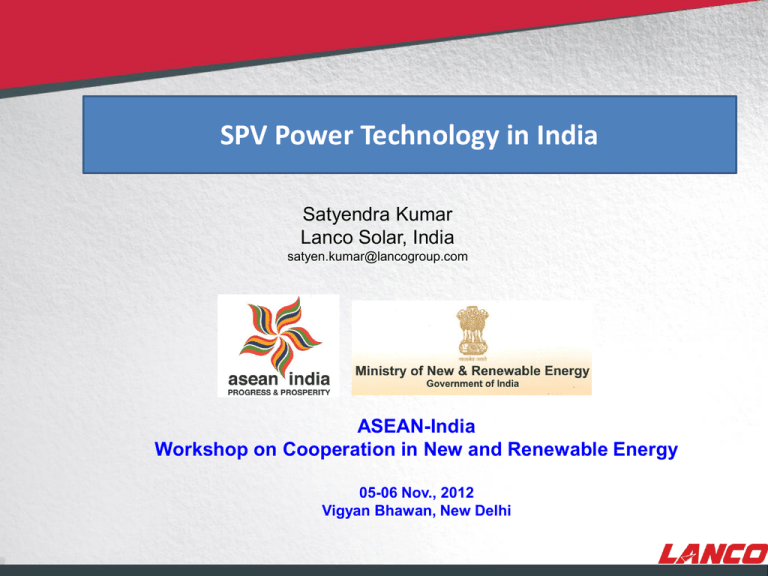
SPV Power Technology in India
Satyendra Kumar
Lanco Solar, India
satyen.kumar@lancogroup.com
ASEAN-India
Workshop on Cooperation in New and Renewable Energy
05-06 Nov., 2012
Vigyan Bhawan, New Delhi
© LANCO Group, All Rights Reserved
Agenda
Power Sector in India – Role Solar Can Play
India’s Current Solar PV Installation Base
SPV Technologies
Lessons Learned
Conclusions
India – Electricity Opportunity
GW
1200
1084
India ranks 5th in terms of Installed
Capacity
1050
1000
126
Pakistan
436
India
778
Brazil
800
2,232
China
2,631
World Avg
2,875
S. Africa
600
India lacks significantly in Per Capita
Consumption
Nigeria
4,759
Russia
6,435
Germany
400
200
280
233
194
138
125
119
104
102
Source: World Bank, CEA
7,149
France
7,931
Japan
8,071
Australia
11,217
USA
0
13,654
UAE
16,891
Canada
17,061
Norway
Source: EIA, CEA
24,867
0
5,000
10,000
15,000
20,000
25,000
30,000
Kwh/annum
Source: D&B Industrial Research Service
India per capita Electricity Consumption is lagging well behind World Average and this would
catch up fast owing to rising levels of Disposable Income
An average of 16 GW of power generation capacity installations required each year till 2020
to meet fast growing demand for electricity power
India has huge potential for solar power deployment
Solar Power Density in India
Source
*Potential
(MW)
Installed (MW)
as on Jan’12
Wind Power
45,000
16,179
Biomass
16,000
1142
Small Hydro
15,000
3300
CogenerationBagasse
3,500
1952
Waste to Energy
2,700
74
Solar
Unlimited
481
Source: * MNRE - Development of Conceptual Framework for REC Mechanism
Solar installed capacity – India
India receives on an average 4-7kWh/m2 of solar energy daily with
an average of 250-300 sunny days in a year
Cumulative grid connected Installed solar power capacity is quite
low in India
Rajasthan and Gujarat receive maximum radiation in the
range of 6–6.6 KWh per square meter
Accounting for a negligible proportion of India’s power
capacity
Capacity additions in Indian solar industry have been miniscule as
compared to the additions globally
India yet to optimally utilize its solar potential
Grid connected Solar Power
(Cumulative Capacity)
1,035 MW
Additions during last year (FY12)
446 MW
Off-grid Solar PV plants
(Cumulative Capacity)
85 MW
Solar Water Heating – Collector
Area
(Cumulative Capacity)
Source: MNRE, Edelweiss Research
(As at June30, 2012
5.63 Mn Sq. m
India Poised to be a Major Global Contributor
Global Solar Market Outlook
Rank
Country
Installed
capacity (GW)
in 2011
Solar Power
Target
Clean Energy
Target
Key incentives
USA :
1
USA
4.6
2020 :~ 16
GW
2
India
0.5
2022 : 22 GW
15.90%
3
China
3.0
2015 : 9 GW
2020 : 50 GW
15% of primary
energy
17%
Production / Investment tax credit
FiTs, REC, Capital subsidy
Feed-in-Tariffs (FiTs), GBI for rooftop
an biding installed PV, Tax incentive
for PV
4
Italy
12.4
NA
17%
FiTs, REC, Tax incentive
5
Spain
5.3
2020 : 8-9
GW
20%
REC, Tax incentive
Australia
1.3
NA
20% of total
consumption
7
Japan
5.0
2020 : 28 GW
22%
25.0
2020 : 50-70
GW
35%
(50% by 2030,
65% by 2040,
80% by 2050)
Germany
Continues to grow rapidly with a 300 MW
in Arizona receiving approvals. Expected
to remain the largest solar market in world
in near future
India :
Rapid growth seen in high potential solar
states of Rajasthan and Gujarat. Gujarat
launches Asia's largest solar park of 600
MW
China :
6
8
India, USA rapidly advancing; EU slow
and steady
Generation Based Incentive (RBI),
Renewable Energy Certificate (REC)
FiTs, REC, Tax incentive
Many large-scale plants commissioned.
Hit by oversupply in the international
export market
Italy, Spain, Germany :
FiTs, REC, Tax incentive
Affected by the sovereign debt crisis and
a weak future economic outlook of the
Euro
Source : Industry Research, Ernst & Young Report on Renewable Energy Country Attractiveness indices
E&Y Solar energy attractiveness Index : India ranked 2nd in the world – only behind USA
Strong National Policy Initiatives at the Centre (JNNSM)
Jawaharlal Nehru National Solar Mission (JNNSM)
Comprehensive framework for development of solar power in India
Covers both solar power generation as well as manufacturing
Incorporates specific fiscal / monetary incentives
Objectives
Installed solar power generation capacity of 20 GW by 2020; 100 GW by 2030 and 200 GW by 2050
To achieve grid parity by 2020
To achieve parity with coal-based thermal power generation by 2030
4-5 GW of installed solar manufacturing capacity by 2017
20 mn solar lighting systems for rural areas by 2022
Institutional Arrangement to support bundling of Solar Power
State Government
(Land, Water, Other
Sanctions)
Central Electricity
Authority
(Technical Support)
CERC
Determines Tariff
Solar Power Developer
National Thermal
Power Corporation
(NTPC)
1 kWh Solar
4 kWh Thermal
NTPC Vidyut Vyapar Nigam
(NVVN)
Buys → Bundles → Sells
State Electricity Boards
(Buyers of bundled power)
Bundled 5 kWh at
INR 4.17/kWh
Note : Rates for SPV and ST based on average bidding tariff. The above rates expected to be achieved on commissioning of all power plants by May 2013
Among the states, Gujarat – Leading the Way
Gujarat
First state to launch an independent solar policy in 2009.
Policy operative till 2014.
PPAs of 969 MW signed. The projects allocated through the
MOU route with pre-qualification criteria
Projects of 690 MW commissioned till 30th June, 2012.
Asia’s largest Solar Park – The Charaanka Solar park in Patan
district of Gujarat inaugurated in April, 2012
An energy surplus state. Does not need to allocate more
projects to fulfill its RPO obligations
Gujarat Energy Development Authority (GEDA) provides
assistance in identification of suitable locations, facilitation in
arranging Right of Way & recommending the project
High investor confidence –
More than 1000MW of projects have pre-registered for
future allocations
Banaskantha
Asia’s largest
solar park
Patan
Surendra Nagar
Tariffs
Projects commissioned
before 31.12.10
Applications worth 1715 MW received for allocation of
150MW
Projects commissioned
after 31.12.14
PV project
(Rs. /kWh)
Thermal projects
(Rs. /kWh)
15 (for first 12 years)
10 (for first 12 years)
5 (from 13th to 25th year)
3 (from 13th to 25th year)
12 (for first 12 years)
9 (for first 12 years)
3 (from 13th to 25th year)
3 (from 13th to 25th year)
…And other states following suit
Particulars
Karnataka
Rajasthan
Madhya Pradesh
Tamilnadu
Policy instrument
Karnataka Solar Policy,
2011-16
Rajasthan Solar Energy
policy, 2011-2017
MP Solar Energy Policy
TN Solar Energy
Policy 2012
Target Capacity
200 MW - DISCOMS upto
2015-16 (40 MW p.a.)
50 MW - Thermal
100 MW - REC mechanism
50 MW SPV; 50 MW ST
200 MW SPV
DISCOMS
announced
Phase I (upto 2013) -200MW
Phase II (2013 - 17) - 400MW
10 MW : MNRE
• 3000 MW by 2015,
50 MW SPV in
including rooftop
2012-13
•1500 MW utility scale
announced
by 205
Capacity Cap
SPV : Min 3 MW, Max 10
MW
ST : Min 5 MW
SPV : Min 5 MW, Max 10 MW SPV : Min 5 MW
ST : Min 5 MW, Max - 50
MW
NA
25 MW
Sale of Energy under
state policy
Reverse bidding
Ceiling tariff :
SPV : INR 14.50 / kWh
ST : INR 11.35 / kWh
Reverse bidding
Ceiling Tariff :
SPV : INR 10.12 / kWh
Reverse bidding
Ceiling Tariff :
SPV : INR 15.35 / kWh
Reverse bidding
Ceiling Tariff :
SPV : INR 15.35 /
kWh
Reverse bidding
Lowest bidder
offered entire 25
MW
14 MW
-
25 projects : 125 MW
8 projects : 37.5 MW
10 projects : 10 MW
-
-
1 project : 5 MW
7 projects : 7 MW
200 MW under State
Policy
Expected allocation of 25 MW
1000MW in 2013
Operational :
State Policy
JNNSM, Phase I
Batch I
Migration scheme
RPSSGP through
IREDA
Bids awarded under
state policy / other
schemes
80MW under State Policy Last date for submission of
30 MW - 30 months of
RfS for 200 MW postponed
PPA;
indefinitely
50 MW - 18 months of PPA
817 MW - REC mechanism
100 MW - NTPC – Bundled
Source: MNRE, State Nodal Agencies, Research Reports
Orissa
Solar RPOs Pushing the Frontiers Further
•
The solar power purchase obligation for the States start with 0.25% in phase 1 (FY2011-2013) and go up to 3% by FY 2022
•
Installed solar capacity by FY 2022 estimated at 38 GW
State
Electricity Consumption (Bn units)
Equivalent Solar Installation capacity (MW) RPPO 3% (FY 22E)
FY13E
FY 22E
Andhra Pradesh
89.0
175.6
Chhattisgarh
21.8
45.1
Gujarat
85.4
156.8
Haryana
38.4
73.8
Jharkhand
23.4
51.7
Karnataka
53.5
107.5
Madhya Pradesh
49.3
99.0
Maharashtra
125.7
219.9
Orissa
27.2
63.1
Punjab
60.5
104.3
Rajasthan
48.9
96.4
Tamil Nadu
87.2
182.8
Uttar Pradesh
79.3
150.2
West Bengal
41.0
84.5
Total
968.7
1,914.5
3,512
902
3,136
1,476
1,034
2,150
1,980
4,398
1,262
2,086
1,928
3,656
3,004
1,690
38,290 MW
Total Grid Connected Installed Capacity Map – India
as on Oct 2012
*Source: MNRE and Bridge to India: Solar Compass: Oct 2012
Solar – Knowledge base and Technology
Solar Resource Assessment (GHI, DNI) :
Satellite Based Estimates & Ground Measurements
Solar Photovoltaics (SPV)
Technology PV production – whole value chain
Equipment PV production – whole value chain
Grid Connected Solar Farms – EPC, Inverters, Monitoring Systems
Engineering
Risk Assessment and Insurance
Financing
Grid Extension, Availability and Stability
What are various SPV technologies ?
c-Si
Mono /
SingleCrystal
Multi /
Poly Crystal
Thin Films
Amorphous Silicon
a-Si
(single
18-23%
15-17.5%
CdTe
CIGS
Organic
~11%
~12%
~5% ?
Tandem /
Junction)
Micromorph/
Double Jn/
Triple Jn
~6-8%
~9-10%
Global Production: Technology Mix
GOVT OF INDIA – DOMESTIC SOLAR MFG ASPIRATIONS
Upstream
Polysilicon
Sand
Mid Stream
Ingot/
Wafer
Cells
Modules
Down Stream
System
Integration
Decentralised
Application
Indian Solar Market demand is growing to be 1GW/yr by next year; and is set to
increase further thereafter, due to Grid Parity achievement
To cater to the Indian market demand following manufacturing capacities are required:
Indian Solar PV
Manufacturing
NSM Goal : 2 GW / yr
Domestic Mfg by 2020
Existing / Under Constr
Indian Capacities
Remarks
Polysilicon
12,000 T/yr
1,800 T/yr (constr)
Lanco
Ingots & Wafers
2,300 MW/yr
300 MW/yr (constr)
Lanco, Birla Surya
Cells
2,200 MW/yr
1,010 MW/yr
Indosolar, Jupiter, BHEL,
Websol, Tata, Moserbaer,
EuroMultivision, BEL, CEL,
SolarSemi
Modules
2,000 MW/yr
1,900 MW/yr
More than 40 companies
© LANCO Group, All Rights Reserved
PV Technology wise status (JNSM)
c-Si Module to be manufactured
domestically
JNSM –Phase I (Batch-1): 150 MW
Module Technology Breakup - by % capacity
37.93%
c-Si cells and Module to be
manufactured domestically
Phase I (Batch-2): 350 MW (Anticipated)
Module Technology
Break-up by %
capacity- Phase 2
Thin-film
c-Si
62.07%
45%
55%
Thin Films
c-si
Cheaper Financing Options decide the technology options – Equipment
comes with funding
Technology share in Gujarat & leading financiers
CIS 1%
Tandems
6%
Am-Si,
24%
Multi,
46%
CdTe,
23%
Technology share of PV projects
in Gujarat totalling 935MW
Cheaper Financing Options decide the technology options – Equipment
comes with funding
16
Technology Vision for the PV Future
What technology is needed
• What is needed to develop that technology
• What challenges it would involve to get commercialized
•
Who needs the PV technology
For what?
Where/When does one need it
Who needs Solar ?
Who needs Solar ? For What?
A Systems Approach
• Top-down Approach – Grid Centric
• Bottoms-up Approach – Off Grid, Needs
Specific Solutions
Photovoltaic Systems
• PV Panels: high efficiency at low cost !
• Inverters: Long Life time ?, Higher efficiencies, Tropicalized,
more intelligent
• Variability of Solar Resource
- Storage solutions: Batteries, Ultracapacitors,….
•
Power electronics – Load Specific
• Transport of power – Availability and Stability of Grid
Frugal Engineering – Tata Nano
Lessons Learned : Lack of reliable radiation data
Move towards building Solar Radiation Atlas
Challenges Faced currently
Project developers have to rely on satellite
information from sources like NASA, NREL, etc
MNRE has initiated a major project on Solar
Radiation Resource Assessment (SRRA)
Uncertainty surrounding the generation potential at
site. Different solar radiation database yield varying
estimates.
Centre for Wind Energy Technology (C‐WET) has
installed a network of 51 Automatic Solar Radiation
Monitoring Stations in different states
The returns of a solar project are highly sensitive to
radiation levels.
Solar Monitoring Stations
Lack of adequate ground-mounted monitoring
stations to validate satellite based estimates
Radiation variability
projected cash flows
could
significantly
affect
22
Lessons Learned : Scale of Projects
Challenges faced due to size of Projects
Steps taken to address the issue
Solar projects are small compared to traditional power
plants
Government realising these challenges has considerably
increased the size of solar PV projects allotted in phase
I batch II of JNNSM
Lenders are reluctant to finance small transactions
From Batch I to Batch II , max capacity allotted to any
developer has increased to 50 MW
In cases where finance is available, transaction costs
are higher
States following the cue, are also encouraging large scale
development which would further bring in economies of
scale.
Higher MW range of projects had to be promoted for
using better evacuation infrastructure
Maximum Cap allotted to a developer for Solar PV
Particulars
Max Cap
Max 5 MW
JNNSM Batch I Phase I
JNNSM Batch II Phase I
Max 50 MW for one developer; each project of max 20 MW
Karnataka
Rajasthan
MP
Gujarat
10 MW
10 MW
No upper Limit
25 MW
Orissa Phase I & II
25 MW
23
SPV Challenge:
The Grid Parity ?
Or
Grid Substitute / Support
Socket Parity
Road to Grid Parity is Blocked by the High Cost of Financing in India
15.0%
Prime Lending Rates (2011) (%)
10.5%
10.0%
9.00%
7.7%
4.90%
7%
5.0%
3%
5.80%
5%
6.70%
5.50%
3.30%
2%
0.50%
0.0%
Source: World Bank
Mode of Solar Financing in India
●
*
Prohibitive cost of financing in India in terms of
*
prevailing interest rates
●
Long-tenure loans not available (15 years and
more) with Indian banks. Stretches cash-flows
during debt service period
* Includes Hedging Cost
• NCDs = Non-convertible Debentures
• ECAs= External Commercial Borrowings
• ECA=Export credit agency
l
25
Roadmap to High Growth & Grid Parity
Interest Subsidy / VGF for Solar Farm; Rs 15 L/
year/MW (for 5-years)
Higher number of RECs for Older Plants
Capital Subsidy / Incentives for domestic PV Mfg
projects – to offset interest & power costs
Every MW of Solar Power Plant create
direct / indirect jobs:
Solar Mfg : 20
Solar Farm Project : 65
O&M : 15
World Class R&D Centre - High
efficiency Solar cells; Reduction in
BOS & Tracking system costs
During 2012-17 : Potential 1,00,000 jobs
Grid Parity – Reliable & affordable
power - Empowerment of rural
population
Domestic Content & ADD support for 2-3 years
THANK YOU!









